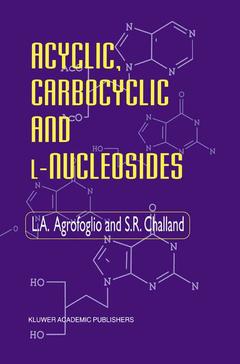Acyclic, Carbocyclic and L-Nucleosides, Softcover reprint of the original 1st ed. 1998
Langue : Anglais
Auteurs : Agrofoglio L., Challand S.R.

Interest in chemical entities capable of blocking or modifying cell metabolism ultimately goes back to the discovery of the structure of DNA in the 1950s. Understanding of the biochemical processes involved in cell metabolism rapidly led to the idea that compounds could be designed which might interfere with these processes, and thus could be used in the treatment of the diseases caused by viral infection. Since then, several classes of drugs have been discovered which depend for their effect on modification of the proper functioning of nucleic acids and, with the introduction of acyclovir for the treatment of Herpes infections, nucleoside analogues have become the cornerstone of antiviral chemotherapy.
The success of the early nucleoside agents, the toxicity and metabolic instability of many nucleoside analogues, and the effects of viral pathogens on public health are driving the design, synthesis and evaluation of new nucleoside analogues, with much attention turning to nucleosides containing `non natural' sugar analogues. This book focuses on the development of these agents, and draws together all the available material in an easily consulted form, which at the same time guides the reader into the research literature on the subject. Written primarily for the medicinal chemist, coverage includes both synthetic strategies and outline guidance on the main trends in biological activity. Particular attention is drawn to the comparison of synthetic routes to compounds with their natural analogues. Finally, the important antiviral activities of the compounds are treated, including anti-retrovirus, anti-hepadnavirus and anti-herpes virus properties.
Written mainly for medicinal chemists in the pharmaceutical industry and synthetic organic chemists in academe, this book will also be attractive to researchers in institutions focusing on cellular metabolism. Advanced students of organic chemistry will find the clear discussion of the synthetic strategies adopted in the development of these compounds a useful introduction to this exciting and challenging area.
The success of the early nucleoside agents, the toxicity and metabolic instability of many nucleoside analogues, and the effects of viral pathogens on public health are driving the design, synthesis and evaluation of new nucleoside analogues, with much attention turning to nucleosides containing `non natural' sugar analogues. This book focuses on the development of these agents, and draws together all the available material in an easily consulted form, which at the same time guides the reader into the research literature on the subject. Written primarily for the medicinal chemist, coverage includes both synthetic strategies and outline guidance on the main trends in biological activity. Particular attention is drawn to the comparison of synthetic routes to compounds with their natural analogues. Finally, the important antiviral activities of the compounds are treated, including anti-retrovirus, anti-hepadnavirus and anti-herpes virus properties.
Written mainly for medicinal chemists in the pharmaceutical industry and synthetic organic chemists in academe, this book will also be attractive to researchers in institutions focusing on cellular metabolism. Advanced students of organic chemistry will find the clear discussion of the synthetic strategies adopted in the development of these compounds a useful introduction to this exciting and challenging area.
Preface. General Introduction. 1. The chemistry of acyclic nucleosides. 2. Biological activity of acyclic nucleosides. 3. The chemistry of carbocyclic nucleosides. 4. Biological activity of carbocyclic nucleosides. 5. The chemistry of L-nucleosides. 6. Anti-viral activities of L-nucleosides. Appendix A: Nomenclature of nucleosides. Appendix B: Abbreviations in widespread use. Appendix C: Glossary of terms used. Appendix D: Acknowledgements. Index.
This book covers both synthetic chemical approaches and biological activity, giving the reader a broad overview of these important compounds. Well illustrated and with copious references, it provides an easy route to the primary literature on these classes of compounds. It focuses on the development of these non natural sugar containing agents, and covers their design, synthesis and important antiviral properties along with comparisons to the related 'normal' nucleosides.
Date de parution : 09-2012
Ouvrage de 383 p.
15.5x23.5 cm
Disponible chez l'éditeur (délai d'approvisionnement : 15 jours).
Prix indicatif 210,99 €
Ajouter au panierThèmes d’Acyclic, Carbocyclic and L-Nucleosides :
Mots-clés :
DNA; chemistry; development; drugs; metabolism; nucleic acid; organic chemistry; pharmaceutical; synthesis
© 2024 LAVOISIER S.A.S.



